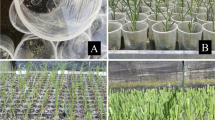Abstract
Using two wheat varieties (Triticum aestivum L., winter ‘Grana’ and spring ‘Jara’) the ability of callus from immature inflorescences to differentiate into new plants was studied. In the case of the winter wheat the requirement for vernalization of the newly developed plants to attain the ability for heading was investigated.
Callus was developed from 1–2 mm fragments of immature inflorescences, 5–10 mm in length, on Murashige and Skoog medium containing 1 mg l-1 2,4-d, 3% sucrose and 0.6% agar, at 25° C and in continuous light of about 6.4 W m-2 PAR energy. After 6 weeks of culture green centres of differentiation were observed. During the following 4 weeks culture on MS medium free of 2,4-d, leaf-like structures as well as a small number of roots were obtained. The regenerants were rooted on a half-strength MS medium, then transferred to pots of soil and placed in a glasshouse with 16 h photoperiod at a temperature day/night 23/17° C.
After about 6 weeks of culture in the glasshouse, almost all regenerants (98%) headed and were fertile, producing normal seeds, including the winter variety. The heading of winter plants under conditions excluding vernalization indicates that the callus tissue derived from a generative organ transmits the state of generative induction onto the developing new plants.
Similar content being viewed by others
Abbreviations
- 2,4-d :
-
dichlorophenoxyacetic acid
- MS:
-
Murashige & Skoog (1962) medium
- H:
-
Hoagland medium
- PAR:
-
photosynthetically active radiation
References
Ahuja P S, Pental D & Cocking E C (1982) Plant regeneration from leaf base callus and cell suspensions of Triticum aestivum. Z. Pflanzenzuchtg. 89: 139–144
Bajaj Y P S (1990) Biotechnology in Agriculture and Forestry, Vol. 13. Wheat. Springer Verlag, Berlin, Heidelberg, New York, Tokyo
Bhaskaran S & Smith R H (1990) Regeneration in cereal tissue culture: A Review. Crop Sci. 30: 1328–1337
Biesaga-Kościelniak J, Marcińska I & Dubert F (1994a) Stimulation the effectiveness of partial vernalization to isolated embryos of winter wheat by the extracts from plants of different stages of generative development. Acta Physiol. Plant. 1: 27–32
Biesaga-Kościelniak J, Marcińska I & Dubert F (1994b) The effectiveness of flowering stimulation in winter wheat under the influence of extracts from plants of various degrees of generative induction. Bull. Polon. Acad. Sci. (In press.)
Butenko R G, Dzhardemaliev Zh K & Gavrilova N F (1986) Plant regeneration from callus tissues originated from different organs of winter wheat. Physiol. Rast. 33: 837–842
Dubert F, Marcińska I, Biesaga-Kościelniak J & Filek M (1989) The application of tissue cultures in the studying of the thermoinduction of generative development of winter wheat (in Polish). Bull. IHAR Vol. 171–172: 153–160
Dubert F, Marcińska I & Kuchalska J (1991) Influence of sucrose and mannitol concentrations on effectiveness of the in vitro vernalization of isolated winter wheat germs. Bull. Acad. Sci., Ser. Sci. Biol. 4391: 57–67
Dubert F, Marcińska I, Biesaga-Kościelniak J & Szmider I (1993) The effectiveness of vernalization of immature embryos of winter wheat var. Grana as related to age and exogenous phytohormones. J. Agron. Crop Sci. 170: 234–242
Lhotowa M & Kucera L (1990) Embryogenic callus induction and plant regeneration from cultured immature embryos of wheat. Genet. Slecht. 26: 257–264
MacKinnon C, Gunderson G & Nabors M W (1987) High efficiency plant regeneration by somatic embryogenesis from callus of mature embryo explants of bread wheat (Triticum aestivum) and grain sorghum (Sorghum bicolor) In Vitro Cell. Develop. Biol. 23: 443–448
Murashige T & Skoog F (1962) A revised medium for rapid growth and bioassay with tobacco tissue culture. Physiol. Plant. 15: 473–497
Ozias-Akins P & Vasil I K (1982) Plant regeneration from cultured immature embryos and inflorescences of Triticum aestivum L. (Wheat): Evidence for somatic embryogenesis. Protopl. 110: 95–105
Sears R G & Deckard E L (1982) Tissue culture variability in wheat: Callus induction and plant regeneration. Crop Sci. 22: 546–550
Sharma H C & Gill B S (1982) Effect of embryo age and culture media on plant growth and vernalization response in winter wheat. Euphyt. 31: 629–634
Sharma H C, Gill B S & Sears R G (1984) Inflorescence culture of Wheat-Agropyron hybrids: Callus induction, plant regeneration, and potential in overcoming sterility barriers. Plant Cell Tiss. Org. Cult. 3: 247–255
Valentine J & Middleton B T (1987) The effect of embryo culture on reproductive development in winter cereals. Cereal Res. Commun. 15: 161–165
Vasil I K & Vasil V (1986) Regeneration in cereal and other grass species. In: Cell Culture and Somatic Cell Genetics of Plants, Vol. 3: Plant Regeneration and Genetic Variability. Academic Press, Orlando. 121–150
Went F W (1957) The experimental control of plant growth. New York, The Ronald Press Comp. 77–80
Whelan E D P & Shaalie G B (1992) Vernalization of embryogenic callus from immature embryos of winter wheat. Crop Sci. 32: 78–80
Zimny J & Lorz H (1989) High frequency of somatic embryogenesis and plant regeneration of rye (Secale cereale L.). Plant Breed. 102: 89–100
Author information
Authors and Affiliations
Rights and permissions
About this article
Cite this article
Marcińska, I., Dubert, F. & Biesaga-Kościelniak, J. Transfer of the ability to flower in winter wheat via callus tissue regenerated from immature inflorescences. Plant Cell Tiss Organ Cult 41, 285–288 (1995). https://doi.org/10.1007/BF00045094
Received:
Accepted:
Issue Date:
DOI: https://doi.org/10.1007/BF00045094




